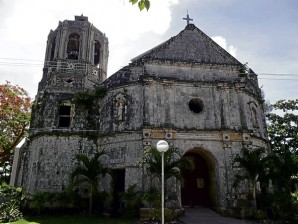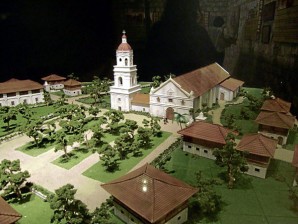Tracing the Spanish roots of Cebu

THE PARISH church was the focal point of every Spanish pueblo. This photoshows the coral-stone church of Santa Rosa de Lima in Daanbantayan, Cebu. TRIZER D. MANSUETO
CEBU CITY—Except for Medellin, Madridejos, Tabuelan and some other places, Cebu’s towns were founded during the more than 300 years of Spanish rule.
The province would have gained more municipalities had the Spanish occupation not been brought to an end in 1898, according to documents titled “Varias Provincias,” which are now crumbling at the Records Management and Archives Office in Cebu City.
Like the rest of the population in the archipelago, the ancient Cebuanos lived in dispersed communities known as barangays, which consisted of families numbering from 30 to over 100.
In 1565, Spanish conquistador Miguel Lopez de Legazpi arrived in Cebu and established the first permanent Spanish settlement. One of his tasks was to gather the Cebuanos in a “reduccion,” an administrative subdivision where the church, convent and government offices were to be located.
The first towns
Natives who were placed under the reduccion facilitated the administration of Western “civilization” and “proselytization.” The task was daunting, however, for the Cebuanos who lived in the coasts and fled to the mountains. The Spaniards had to gather many of them who refused to submit themselves to foreign conquest and conversion from far-flung and thickly forested areas.
A town (or “pueblo”) is usually defined as a collection of dwellings and other buildings, larger than a village, especially one not converted into a city. During the early days of conquest, the erection of a parish was also construed as the founding of a town.

A scale model of the Spanish-era Argao “pueblo,” showing the church-plaza complex, is displayed at Museo Sugbo in Cebu City. TRIZER D. MANSUETO
In Cebu, four towns were established as parishes. These were Santissimo Nombre (Cebu City), which was founded in 1565, Bantayan (1580), San Nicolas (1584) and Sialo or Carcar (1599).
The 17th century saw the rise of only five towns. The district of Parian was organized into a town in 1603, followed by Boljoon in 1606, Argao in 1608, Barili in 1614 and Mandaue in 1638.
The following century, four more towns and parishes were organized—Dalaguete in 1711, Danao in 1742, Opon in 1744 and Samboan in 1784.
Only a few towns were established from the 16th century to the 18th century because many places either suffered from destruction or decline as a result of Moro piratical raids. Christian villages were greatly affected by the menace.
Those who were able to escape the Moro depredations moved to the hinterlands. Other areas that were not threatened by the attacks showed significant developments.
Cebu underwent a demographic transformation from 1780 to 1830, triggering a rise in population. This happened because of the shift in staple grain from millet to corn and the resulting expansion of subsistence agriculture, as well as the more effective local resistance to the Moro raids.
(Millet was the staple food of the pre-Hispanic Cebuanos but corn later replaced it, after corn was introduced from Mexico.)
The development of domestic commerce and localized trading networks was also another reason.
Fr. Julian Bermejo, the Augustinian parish priest of Boljoon (1804-1848), led the antipiracy campaign in Cebu. He supervised the construction of watchtowers (“bantayan sa hari,” “lantawan” or “baluarte”) from Sibonga to Santander and early warning system whenever Moro ships arrived.
The opening of the Cebu port to world trade in 1860 contributed to the growth of the economy. Soon, the province was exporting sugar, abaca and other local products, which resulted in the establishment of foreign commercial houses.
On June 23, 1830, Don Manuel Romero, the “alcalde mayor” of Cebu City, drew up some regulations to be implemented by the “gobernadorcillos” and other town officials in Cebu.
The regulations were very timely, as towns were being founded one after the other from north to south of the province. These not only spelled out the proper manner government officials should act but also stipulated the grid layout of residences and streets.
Romero’s regulations were just an elucidation of a royal ordinance on town planning issued by King Philip II of Spain in 1573.
Before these were issued, two more parishes were already established at the turn of the 19th century. These were Badian in 1825 and Naga in 1829. It could not be ascertained if these parishes became towns, but the declaration of a parish was enough assurance that the settlement was, in fact, a town.
Parishes
Towns organized during this period were not necessarily parishes, however. A settlement could be declared a town although it was just the “visita” of another parish. Naga, for example, was for many years a visita, or a subsidiary chapel of the parish of San Nicolas.
From 1830 up to 1850, 12 parishes were erected in Cebu. The town of Sibonga was declared a parish in 1830, followed by Sogod in 1832, Malabuyoc in 1834, Talisay and Catmon in 1836, Liloan in 1845, Oslob, Poro and Ginatilan in 1847, and Bogo, Mabolo and Pinamungahan in 1850.
From 1851 up to 1897, 24 parishes were established. Santander was the last to be put up in 1897, a year before the Spaniards were expelled from Cebu.
Before the end of the Spanish occupation, a few settlements might have become towns but were never given spiritual independence as parishes.














